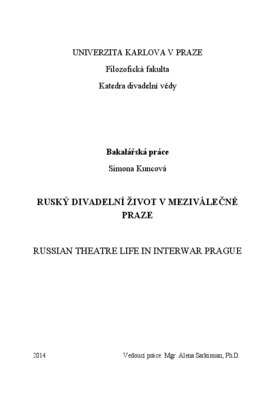Ruský divadelní život v meziválečné Praze
Russian Theatre Life in Interwar Prague
bakalářská práce (OBHÁJENO)

Zobrazit/
Trvalý odkaz
http://hdl.handle.net/20.500.11956/63952Identifikátory
SIS: 134082
Katalog UK: 990018512860106986
Kolekce
- Kvalifikační práce [24991]
Autor
Vedoucí práce
Oponent práce
Just, Vladimír
Fakulta / součást
Filozofická fakulta
Obor
Divadelní věda
Katedra / ústav / klinika
Katedra divadelní vědy
Datum obhajoby
8. 9. 2014
Nakladatel
Univerzita Karlova, Filozofická fakultaJazyk
Čeština
Známka
Velmi dobře
Klíčová slova (česky)
Ruské divadlo, emigrace, Pražská skupina MCHAT, kačalovská skupinaKlíčová slova (anglicky)
Russian theatre, emigration, Prague MAT Group, Kachalov groupTato bakalářská práce se zabývá divadelními aktivitami ruských umělců, kteří přijíždějí do Prahy mezi dvěma světovými válkami v důsledku politických nepokojů v jejich vlasti. V první části práce je pojednáno o přístupu Československého státu k ruským emigrantům, detailněji je pak nazíráno na to, jaké možnosti Československo poskytovalo ruským divadelním umělcům. Ve druhé části práce je představena tzv. Pražská skupina MCHT, soubor umělců Moskevského uměleckého divadla, který měl v letech 1923 - 1927 stálé sídlo v Praze. Výklad začíná vznikem tzv. kačalovské skupiny, z jejíchž řad vzešla většina členů Pražské skupiny MCHT. Následně je představena samotná Pražská skupina a na příkladu třech jejích inscenací je sledován její umělecký vývoj.
This bachelors thesis investigates theatre activities of Russian artists who arrived in Prague between the first and second world war as a consequence of political clashes in their country. The first part of the thesis looks at the attitudes of Czechoslovak nation towards Russian immigrants, in particular the opportunities Russian theater artists were given in Czechoslovakia. In the second part of the thesis, the so-called Prague MAT group is introduced. This is a group formed of artists from the Moscow Arts Theatre permanently located in Prague. The so- called Kachalov group, from which the majority of the Prague MAT group originated, is investigated first. This is followed by the introduction of the Prague group as such. Its developments are explored by looking at three of the group's plays.
